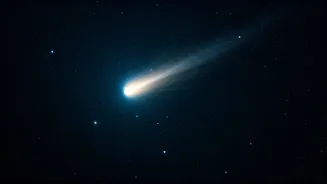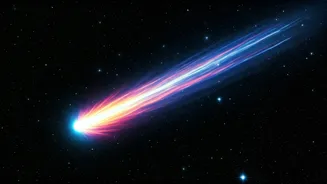Comet Unveiled
The 3I/ATLAS comet, an interstellar wanderer, has captivated the world due to its extraordinary nature and journey through our solar system. The comet, unlike
the ones that originate from our own solar system, comes from a different star system. This celestial body, when it made its approach, generated considerable interest among astronomers and space enthusiasts. Its unusual path and composition distinguish it from other comets, leading to extensive research. One of the main sources of attention was when it came closest to the sun. This rare event offered a remarkable chance to study a comet of interstellar origin, allowing scientists to gain valuable insights into the formation and evolution of other planetary systems.
Why It Matters
The scientific community sees the 3I/ATLAS comet as a valuable object for research because of its interstellar origin. Unlike comets native to our solar system, this comet comes from a different star system, providing a unique look into the formation of planetary systems beyond our own. The study of its composition, trajectory, and behavior can shed light on the diversity of materials and conditions that exist in other stellar environments. The close approach of the comet to the Sun offered a rare opportunity for scientists to gather data and learn about the interstellar materials and their journey across vast distances in space. This data can inform the knowledge about the universe and add to the understanding of how stars and planets come to be.
Elon's Concerns
Elon Musk's comments about the 3I/ATLAS comet sparked significant discussions and concerns. Elon stated that the comet was not an ordinary comet, and his warning added a layer of speculation and apprehension. The reasons behind Musk's warning remain unclear, causing people to consider various possibilities. While the scientific community has been studying the comet from a purely scientific viewpoint, the warning from such a notable figure raised public interest. This event highlights the importance of open communication and data sharing regarding celestial events, especially when it involves public figures and their interpretation of scientific events. It emphasizes the need to consider different viewpoints and the implications of space exploration.
Spotting 3I/ATLAS
For those eager to catch a glimpse of the 3I/ATLAS comet, the key is understanding the comet's visibility and its position in the sky. The best time to observe the comet is when it is closest to the Earth, usually, around the time it approaches the Sun. Because comets have a somewhat unpredictable nature, its brightness and visibility can fluctuate. It is best to check the latest astronomical data and updates. This information can include predictions on the comet's brightness, the best viewing times, and the direction in the sky where the comet will appear. Using a telescope or binoculars is highly recommended. The specific details, like exact timings and viewing directions, are frequently updated by astronomical organizations.














